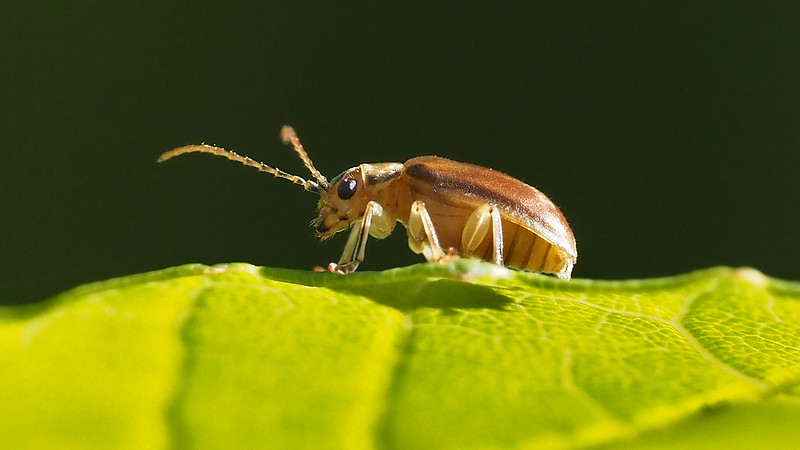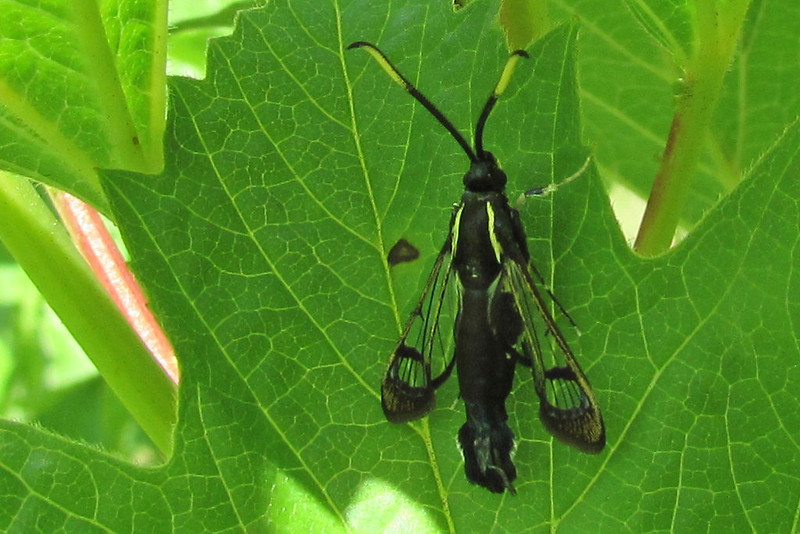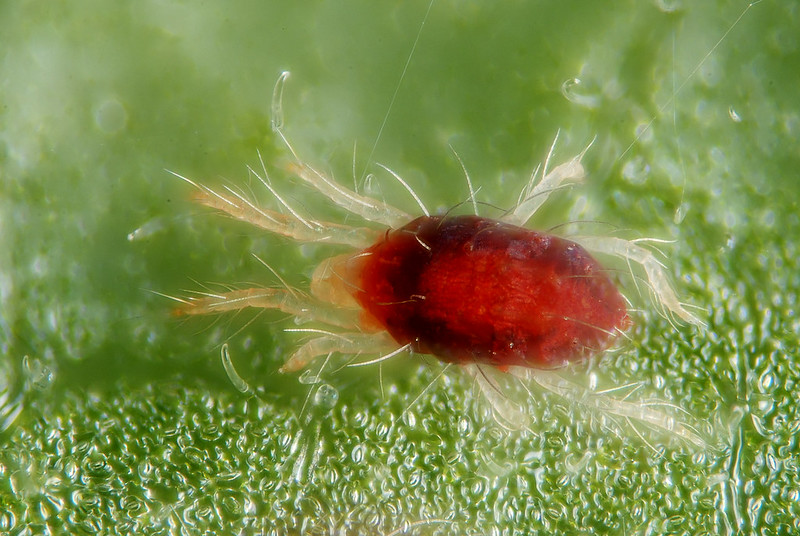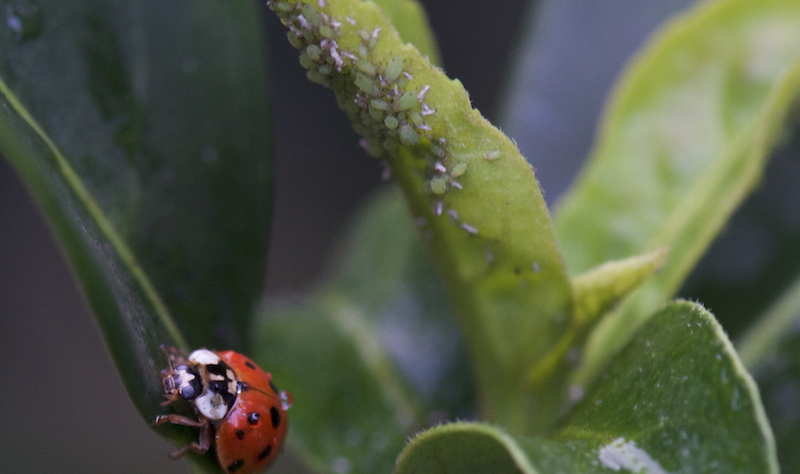Viburnums are popular shrubs that provide stunning flowers and colorful fruit in the landscape. Although viburnums are easy to care for, they are favored by several pests, including insects and mites. Many pests, such as aphids, mites, scale, and thrips, usually only cause cosmetic damage, while pests such as viburnum leaf beetles, borers, and root weevils can cause more serious damage. With regular monitoring and treatment, your viburnum will be healthy and pest-free.
Common Viburnum Pests
Viburnum Leaf Beetles
Viburnum leaf beetles, Pyrrhalta viburni, are an invasive pest of viburnum, introduced from Europe. These insects feed entirely on viburnums, chewing holes into the leaves of these shrubs. The feeding damage from viburnum leaf beetles and larvae resembles the lacy patterns left by Japanese beetles. Viburnums can be entirely defoliated by the end of the growing season. If continuous infestations occur in subsequent years, the viburnum may die.
In summer and fall, eggs are laid inside the twigs and branches of viburnums. Females chew rows of tiny holes on the underside of the branches, sealing them off with the chewed bark once the eggs are deposited. The eggs overwinter, hatching in late spring. The caterpillar-like larvae are less than 1/2-inch long with black dashes lined along their yellow-to-brown bodies. By mid-summer, the larvae finish pupating and emerge as adults, which look like small, brown and yellow beetles.

Treating Viburnum Leaf Beetles on Viburnum
If a small amount of larvae or beetles are present on the plant, they can be manually picked off and destroyed. Prune off infested branches when the population is larger. Inspect twigs and branches for eggs laid by viburnum leaf beetles. Look for lines of bumpy, tan-colored spots on the underside of small branches and new growth. Prune out the branches or treat them with horticultural oil in early spring. Larvae can be managed with labeled insecticides.
Preventing Viburnum Leaf Beetles on Viburnum
Certain species of viburnum are more susceptible to viburnum leaf beetles than others. Grow more resistant species such as Koreanspice viburnum (V. carlesii) and doublefile viburnum (V. plicatum). In areas where viburnum leaf beetles are a problem, avoid planting susceptible species such as cranberrybush viburnum (V. opulus) and arrowwood viburnum (V. dentatum). Lacewings and assassin bugs are among the many insects that eat viburnum leaf beetles. Encourage predatory insects to visit your yard by planting a variety of trees and flowering plants.
Viburnum Borer
Viburnum borers are moths that feed on viburnum. Both Synanthedon viburni and Synanthedon fatifera damage these shrubs. As the name suggests, the larvae of these moths tunnel into the bark and vascular cambium, which is the tissue beneath the bark that helps transport water and nutrients. In doing so, the health of the plant is negatively affected, leading to dieback, stunted or distorted growth, decline, and eventually the death of the entire shrub.
Viburnum borers lay eggs into the bark of viburnums in mid-summer. Adult viburnum borers of both species look different from other moths. With clear wings and black and yellow markings, these insects almost resemble wasps. The larvae are caterpillars that are red, brown, and white in color. Viburnum borers almost always tunnel a few inches above the base of the shrub. Since larvae live underneath the bark, they may be difficult to see or control. Look for signs of borers such as scarring on the bark tissue, sawdust, and masses of growth.

Photo by Tim Fenske
Treating Borers on Viburnum
Control is often difficult or ineffective, as the larvae tunnel beneath the bark, and the adults are quick fliers. While prevention is the most effective way to deal with viburnum borers, treatment is best achieved with insecticides. Use a permethrin-containing insecticidal spray. Start applying it to the ground and bottom of the shrub in spring, thoroughly soaking the bark. Reapply several times in early to mid-summer.
Preventing Borers on Viburnum
To prevent damage from borers, keep your viburnums healthy and free from damage, as viburnum borers are more likely to lay eggs near wounds on viburnum plants. Stressed, newly planted, or unhealthy plants are also more susceptible to viburnum borers. Keep young and newly planted shrubs well watered until established. Fertilize mature viburnums once per year in spring. Inspect your viburnums regularly for signs of other pests and diseases. Keep close attention to your viburnum during and after pruning, since pruning can result in wounds that borers may lay their eggs in.
Mites
Several species of mites feed on viburnums, including two-spotted spider mites, southern red mites, and broad mites. Two-spotted spider mites are orange-yellow with two dark-colored spots on their body. They are often seen on the undersides of leaves. Layers of fine webbing will also be present. Two-spotted spider mites are favored by warm weather and lack of precipitation in summer. Southern red mites are red in color and are most active in the cooler months of spring and fall. Broad mites are almost never seen due to their tiny size, but damage will be evident.
While mites are unlikely to kill viburnums, they can weaken or disfigure plants. Damage from mites looks like distorted, stunted, and curled growth. The leaf tissue will pale or turn purple, red, brown, or white. Since mites suck the sap from plants, small, light-colored specks may be present on the leaves. Premature leaf drop is also common. Newer growth is often affected before older growth.

Photo by Gilles San Martin, unmodified, Flickr, Copyright CC BY-SA 2.0
Treating Mites on Viburnum
Spray infested branches with water to knock the mites off of the plant. Horticultural oil and insecticidal soap will also control mites on viburnum. Apply to both the upper and undersides of the leaves. Re-apply the pesticides every 1-2 weeks to ensure that all mites are targeted. All insecticides should be applied when temperatures are cool. Apply them carefully to avoid contact with non-target insects. Mites are tiny arthropods that may be difficult to see without magnifying tools. Monitor for mites on your viburnum regularly by shaking them onto a piece of white paper.
Preventing Mites on Viburnum
Be mindful of beneficial organisms when applying horticultural oil or insecticidal soap to your viburnums. The depletion of mites’ natural predators leads to an increase in the mites’ reproduction and population. Often, mite populations get worse after insecticides are applied due to the effects on non-target insects and arthropods. Avoid using systemic pesticides, instead opting for more selective substances as mentioned above. Predatory mites are the best biocontrols for mite pests. While they are commercially available to release in your yard, you may also encourage local populations of predatory mites onto your property by creating favorable conditions and avoiding non-selective pesticides.
Thrips
Thrips are little insects that feed on the sap of viburnum and many other plants. These pests are often spotted on the underside of leaves in spring through fall. Flecks of yellow, purple, or silver will be seen on the surface of leaves. When damage is severe, leaves will drop early and flowers will fail to develop or open. Viburnums will usually recover from thrips damage, but recurring infestations can cause long-term damage or weakening. Thrips can also vector numerous plant diseases.
Treating Thrips on Viburnum
Horticultural oils, soaps, and insecticides can all be used to treat thrips. When spraying, be sure to target the thrips directly. Most chemicals will be ineffective unless the thrips are thoroughly coated with the spray. Multiple applications every 1-2 weeks will be needed to fully kill the thrips. Soil drenches, which are pesticides applied to the root zone, may also be effective.
Be persistent and check on your viburnums every few days to monitor for thrips. While these insects are small and hard to see, their characteristic flecking and striping of plant leaves will determine their presence. Since thrips will likely not kill your plant, treatment is not always necessary. Be wary of harming non-target insects such as pollinators and predators of thrips when using pesticides.
Preventing Thrips on Viburnum
When managing thrips, prevention is more important than treatment. Remove weeds from your yard to reduce food sources for thrips. Closely inspect and quarantine new plants for thrips before adding them to your garden. These pests are generalists that will feed on numerous species of plants. The fewer food plants available for thrips, the less likely these pests will target your viburnum or other landscape plants. Rake and destroy all fallen leaves from the viburnum to prevent re-infestation.
Root Weevils
Many species of root weevil feed on viburnums, the most common being the black vine weevil, Otiorhynchus sulcatus. Adult weevils are black or brown, flightless beetles with a long snout. The larvae are small, creamy white grubs. Damage from root weevils differs based on the life stage of the pest. The larvae cause more significant damage than the adults, as they feed on the plant’s roots. In extreme cases, roots may be girdled from the damage. This can lead to wilting or yellowing of the leaves, early leaf drop, dieback, and death of the entire plant. Adult weevil damage is less severe, as they only chew half-circles into the leaf margins. Root weevils are active from spring through fall. Both the adults and larvae are rarely seen, since the adults are mostly nocturnal and the larvae live exclusively in the soil.
Treating Root Weevils on Viburnum
Controlling adult root weevils will ensure that future generations of larvae will not damage your viburnum. Adults must feed extensively on the foliage of plants to be able to lay eggs. Select an insecticide labeled for control of weevils. Apply it every 2 weeks as soon as weevil damage is noticed on the leaves. Be sure to spray around the base of the plant to target adults resting at the top of the soil. A parasitic nematode, Heterorhabditis bacteriophora, is commercially available to kill weevil larvae in the soil.
Preventing Root Weevils on Viburnum
It is difficult to prevent root weevils due to their elusive nature and lack of natural predators, as they were introduced from Europe. Inspect your viburnums regularly for signs of weevil damage, such as notched leaf edges. Adult weevils usually hide in leaf litter or in between leaves when they are not feeding at night. Look for adult weevils at the base of your viburnums during the day. Catching individual weevils early will prevent them from laying eggs in the soil around your viburnum.
Aphids
Active throughout the growing season, aphids are soft-bodied, sap-sucking insects in hues of green, orange, or gray. Stunted and curled growth are common symptoms of aphid damage, particularly on new growth. Aphids also excrete sugary honeydew that attracts ants, wasps, and other pests. The honeydew can eventually lead to sooty mold, a harmless, yet unsightly fungal growth. While sooty mold will not kill the plant, it will coat the plant and surrounding areas with a sticky, black growth. Aphids are primarily an aesthetic concern and will not directly kill viburnums. However, they may be vectors of diseases that can negatively impact the plant’s health.

Treating Aphids on Viburnum
Since aphids do not directly harm viburnums, treatment may not always be necessary. Smaller populations can be managed by spraying them off with a hose. Prune and destroy any severely infested stems and branches. Horticultural oil or insecticidal soaps can be used to control aphids. Spray the oil or soap directly onto the pests, coating stems and leaves evenly where they are present. Further chemical control is usually not warranted.
Preventing Aphids on Viburnum
Aphid populations are often kept in check by predatory insects. When populations of ladybugs, lacewings, and parasitoid wasps are abundant, aphid populations will be lower. Planting and maintaining a native, biodiverse habitat will encourage aphids’ natural predators to visit your garden. Limit pesticide use to prevent harming these beneficial insects. Avoid using systemic pesticides, especially while your viburnums are blooming. Removing weeds and other unwanted plants will also reduce the aphid population, as there will be fewer hosts for them to feed on. Use a slow-release fertilizer once per year in spring for your viburnum. Overfertilizing viburnums can result in excess flushes of new growth that attract aphids.
Scale
Like their relatives – thrips and aphids – scale insects use their piercing-sucking mouthparts to sip sap from the plant’s vascular system. Unlike their relatives, however, these insects are immobile for most of their life cycle. Since the adult insects latch onto the plant, they look like small, round bumps on the branches of viburnums. The mobile nymphs, called crawlers, are active in spring, although they are tiny and difficult to spot.
Scale damage is often similar to that of aphid damage, appearing as curled, stunted, and weakened growth. When the scale population is high, dieback will occur. The presence of scale insects can also lead to the development of sooty mold via honeydew.
Treating Scale on Viburnum
Infested branches should be pruned immediately. Small populations of scale can be scraped off of the plant with fingernails or a toothbrush. Scale insects protect themselves with a hardened, waxy covering. Therefore, chemical treatment may not be effective against adults. Scale treatment is best used during the crawler stage in spring. Start applying a horticultural oil as soon as growth begins in early spring. Reapply the oil every 1-2 weeks to ensure that all eggs and crawlers are killed. A systemic pesticide applied per label instructions can also target adult scale insects.
Preventing Scale on Viburnum
Scale insects have many natural predators, such as lacewings and parasitoid wasps. Scale populations are kept low when their predators’ populations are thriving. Therefore, avoid using pesticides that may inadvertently harm beneficial insects. Controlling ant populations can also prevent and reduce scale infestations. Ants eat the sugary honeydew excreted by scale, and will guard them against predatory insects. Remove weeds and nearby ant colonies to allow predators to thrive.
Viburnum Pests Chart
|
Pest |
Identifying |
Treating |
|
Viburnum Leaf Beetles |
Small, brown and yellow beetles |
Manually pick off and destroy, prune infested branches |
|
Viburnum Borer |
Dark wings with distinctive orange bands and a metallic blue body |
Use a permethrin-containing insecticidal spray |
|
Mites |
Orange-yellow with two dark-colored spots on their body |
Spray infested branches with water to knock the mites off of the plant |
|
Thrips |
Tiny, slender insects, usually about 1-2 millimeters in length, with fringed wings |
Use horticultural oils, soaps, and insecticides |
|
Root Weevils |
Black or brown, flightless beetles with a long snout |
Select an insecticide labeled for control of weevils and apply every 2 weeks |
|
Aphids |
Soft-bodied, sap-sucking insects in hues of green, orange, or gray |
Spray them off with a hose, prune and destroy infected stems and branches |
|
Scale |
Small, round bumps on the branches |
Prune infested branch immediately, scrap off plant with fingernails or a toothbrush |
Sources:
"Viburnum Diseases and Insect Pests." Clemson University Cooperative Extension Service. hgic.clemson.edu
"Viburnum (Viburnum)." University of Kentucky. uky.edu
 |
Lauren Youngcourt - Published 08-23-2023 |
